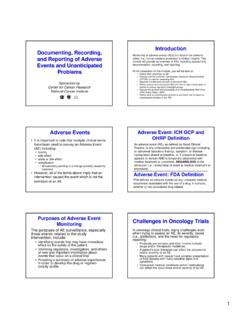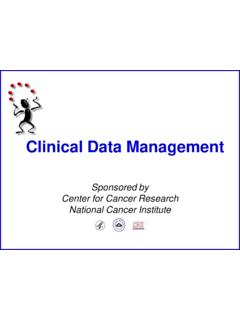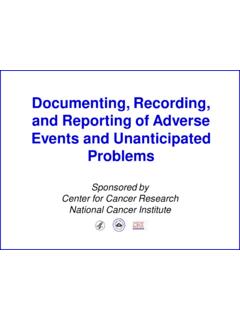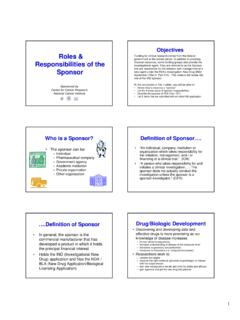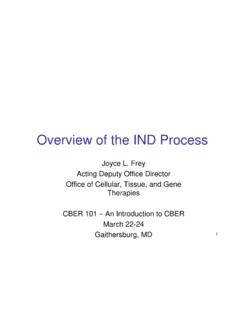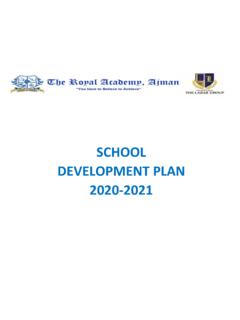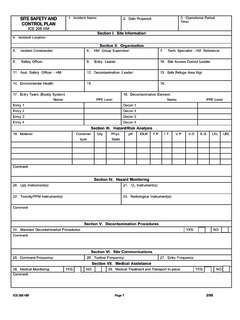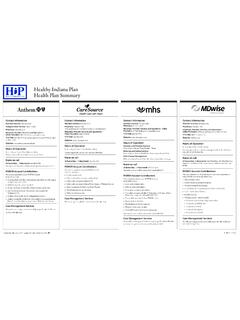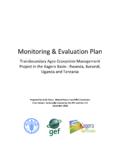Transcription of Monitoring & Auditing of Clinical Trials
1 Monitoring & Auditing of Clinical Trials Sponsored by Center for Cancer Research National Cancer Institute Objectives Guidelines suggest that following the good Clinical research practice of Monitoring / Auditing should be done for the reasons previously stated. That is why, whether you participate in FDA regulated research or not, there should be some local policies and procedures in place for the routine evaluation ( , an audit) of a Clinical trial. At the conclusion of this module you will be able to: Describe the purposes and regulations related to Monitoring of Clinical Trials . Discuss the difference between Monitoring and Auditing . Describe three types of sponsored study visits. Describe the preparation required for and what is reviewed during a Monitoring visit. Describe three types of audits conducted for Clinical Trials Overview Monitoring and Auditing of Clinical Trials is necessary to assure that the: rights and safety of patients ( , human subjects) are protected reported trial data are accurate, complete, and verifiable from source documents conduct of trial is in compliance with protocol, good Clinical practice (GCP) and applicable regulatory requirements.
2 When conducting an IND trial, the regulations require the sponsor to monitor the study. Monitoring Auditing Act of overseeing the progress of a Clinical trial Systematic and independent examination of the trial related activities and documents 100% source document verification of all participants Snapshot in time of a subset of participants Ensuring that the study is conducted, recorded and reported in accordance with: Protocol, SOPs, GCPs, All applicable regulatory requirements Determine whether the trial related activities were conducted and data recorded accurately, analyzed and appropriately reported according to: Protocol Sponsor s SOPs GCP All applicable regulatory requirements Each protocol will outline a data safety and Monitoring process and plan Some studies may require a data safety Monitoring board/committee (DSMB/DSMC) Types of Monitoring Plans PI/research team plan Should be included in the protocol IC Program/QA Plan Data and safety Monitoring board/committee (DSMB/DSMC) Required for certain types of studies.
3 See NCI IRB site Sponsor (IND/IDE) plan Data Safety Monitoring Board An independent and external group Monitor data for safety and emerging efficacy the progress of a Clinical trial safety data critical efficacy variables Usually large, multi-site Trials and/or high-risk Always for randomized, blinded studies make recommendation to the sponsor Continue, modify or terminate a trial Sponsored Trials Several types of site visits conducted by the sponsor Pre-study qualification visit Initiation visit Monitoring visit Close-out visit Pre-study Qualification Visit Purpose: Determine the site's ability to conduct the Clinical trial prior to commencement of the investigation. often place new Trials at sites with a good track record of success Goal of the pre-study qualification visit: Visit the site Meet with study staff Inspect the facilities Sponsor contacts PI Need to determine who the sponsor wants to meet with and what they want to see at the site Allow 2-3 hours for the visit Types of Site Visits The next several slides will review the common types of site visits that will be conducted by a Sponsor: Initiation Visit Routine Monitoring Visit Close-out Visit Purposes of Initiation Visit Assure PI and site staff understand.
4 Roles/responsibilities/regulatory obligations Protocol procedures CRF completion instruction review Requirements for records management/retention Drug handling requirements Enrollment and consent procedures Expedited adverse event reporting procedure Patient recruitment resources Identify potential problems and concerns Timing and Scheduling of an Initiation Visit Timing of visit: Prior to patient enrollment After all essential documents in place After supplies received After IRB approval Sponsor/CRO contacts PI/RN Mutually agreed upon date/time Letter sent to confirm date/time, location, number of attendees Agenda developed and sent by sponsor Attendees Sponsor/CRO: Clinical Research Associate (CRA)/Monitor Medical Monitor Project Manager Site: PI/AIs Research Nurse Data Manager Pharmacist Research Nurse and Data Manager should plan to attend entire meeting.
5 The PI and pharmacist will need to attend, at a minimum, at time designated by the agenda. Others may attend as appropriate. Preparing for an Initiation Review protocol and any other documents received by sponsor/CRO ( : CRFs, Investigator Brochure) Become familiar with the study s procedures Confirm supplies received ( : drug, binders, test tubes, regulatory binder, etc.) ..Preparing for an Initiation Visit Write down questions for sponsor/CRO when reviewing documents Secure room Ensure staff availability for the visit Research nurse to remind staff involved a few days in advance During the Initiation Introductions Develop CRO & Site Contact List Review protocol Focus on eligibility criteria, drug, and study procedures Review AE and expedited AE reporting requirements Review regulatory obligations Sponsor and PI responsibilities ..During the Initiation Visit Review study documentation Drug accountability forms CRFs Logs (enter this visit on the site visit log) Review Regulatory Binder Obtain signatures for Signature Log Obtain signatures for Monitoring Log Start delegation of accountability log Review sponsor/CRO Monitoring Plan Pharmacy/site tour After an Initiation Visit Site to follow-up with sponsor/CRO on outstanding issues ( : missing CV, CLIA, missing supplies, etc) Monitor sends final site initiation visit report File in the Regulatory Binder Purposes of the Routine Monitoring Visit Review progress of a Clinical study Ensure protocol adherence Assure accuracy of data Assure safety of subjects Regulatory Compliance (CFR & GCP) Timing and Scheduling of Routine Monitoring Visits Timing/Frequency Depends on.
6 Complexity of the protocol Disease being studied Rate of recruitment PI/staff experience Site performance Sponsor s SOPs Frequency not dictated by FDA regulations, but FDA will hold Sponsor accountable for their SOPs. Monitor contacts PI/RN requesting the first Monitoring visit (email, phone call) Date and time negotiated Monitor confirms via letter to PI Date and time Expectations of visit Which record/patients will be reviewed Attendees Sponsor/CRO Clinical Research Associate (CRA)/Monitor Site PI, AIs Research Nurse, Protocol Coordinator Data Manager Pharmacist Research Nurse and Data Manager should plan to attend entire meeting. The PI and pharmacist will need to meet w/Monitor at pre-assigned time. The next several slides review how to prepare for a successful Monitoring visit. Also, review the CCR SOP on Coordination of Audit/ Monitoring Visit.
7 Securing Room/Record and Availability of Staff Review CCR SOP on the Coordination of Audit/ Monitoring Visit. Addresses: Request medical records to be reviewed Arrange for a quiet room Inform pharmacy of visit and schedule appointment make sure PI and AIs will be available for Monitoring date. If multiple Monitoring visits occur simultaneously, make sure each sponsor has a separate room to ensure privacy and confidentiality Regulatory make sure Regulatory Binder is complete and up to date: All protocol versions and approvals All Investigator Brochure versions Lab certifications and normal ranges All versions of Form 1572 CVs, licenses and Financial Disclosures for all Investigators signed and dated All IRB correspondence All Sponsor correspondence SAEs Update Delegation of Responsibility/Signature Log as needed ..Regulatory Review Assure IRB receipt of Amendments SAEs Continuing Reviews Assure all participant original consents are in the medical record, signed & dated Note, original consents are sent to medical records to be scanned and loaded into CRIS.
8 Source Document Assure medical records contain All laboratory reports X-ray, scan reports Physician notes, nursing notes Drug compliance/administration notes Procedures documenting study parameters reported in CRF s Informed consent process documentation Obtain missing information or document why unobtainable ..Source Document Review Flag the medical record to assist monitor s retrieval of information in a time efficient manner make sure laboratory reports and procedure reports are reviewed and signed by PI (if required per sponsor SOP) Review CRF s Assure CRF s are complete, accurate, up to date Review adverse events Assure attribution of events is documented Review concomitant medications Assure stop & start dates are recorded Review study medications Assure stop & start dates are recorded Review Pharmacy Records Pharmacy should review drug dispensing records prior to visit Drug Accountability Record Forms (DARFs)
9 Assure drug count is accurate Disposal of returned meds Assure notes to file are written for any discrepancies Inform PI of discrepancies Steps to make the Monitoring Visit Go monitor s current CV is in Medical Records all charts, CRFs and regulatory files in monitor room only charts and files for studies listed in letter monitor and escort to the designated room format of medical record with monitor monitor to appropriate areas on unit such as bathroom, phone appointment times with PI and Pharmacy ..Steps to make the Monitoring Visit Go Smoothly in on monitor in short intervals to ensure all questions are answered monitor to pharmacy and PI office at appointed times time for corrections of CRFs Monitoring visits that are over multiple days, ensure that medical record and files are kept in a locked room up next visit at the end of the current visit Site s Expectations of the Monitor Monitor will come prepared Be knowledgeable about the protocol Communicate honestly about findings Show cooperation, respect, and courtesy Appreciate the effort that went into the preparation Monitor s Expectations of the Site Site will have prepared for the visit Records will be organized so they can work efficiently and finish on time Communicate honestly about findings Show cooperation, respect.
10 And courtesy Appreciate the effort that went into the preparation After the Monitoring Monitor meets with PI/RN to: Share findings Identify needed corrections, if applicable Identify remedial training needs, if applicable Answer questions Set up next visit Monitor will sign Visit Log, if not done already, and site staff will need to initial Return all medical records to Medical/Legal ..After the Monitoring Visit Site answers queries/clarifications May be done during the Monitoring visit Corrected CRFs may be sent to monitor or picked up at next visit Monitor sends Monitoring visit report Placed in the Regulatory Binder Monitor sends follow-up letter of thanks and confirmation of next visit Common Deficiencies Failure to follow the protocol Failure to keep adequate and accurate records Problems with the informed consent form Failure to report adverse events Failure to account for the disposition of study drugs Purpose of a Close-Out Visit To review: All regulatory documents All drug accountability record forms (DARFs) Review record retention guidelines Timing and Scheduling of Close-out Visit Timing: Study is complete Investigator obligations fulfilled All data has been retrieved, entered and database locked Sponsor decision.
